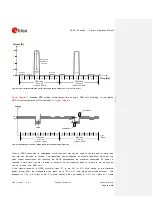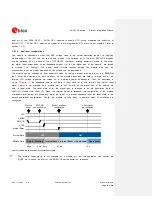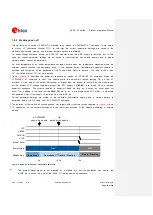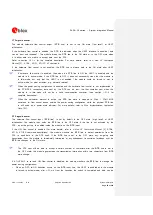
SARA-G3 series - System Integration Manual
UBX-13000995 - R06
Objective Specification
System description
Page 37 of 218
Table 7: RTC value reliability as function of V_BCKP voltage value
Consider that the module cannot switch on if a valid voltage is not present on
VCC
even when the RTC
is supplied through
V_BCKP
(meaning that
VCC
is mandatory to switch on the module).
The RTC has very low power consumption, but is highly temperature dependent. For example at 25 °C,
with the
V_BCKP
voltage equal to the typical output value, the power consumption is approximately 2 µA
(refer to the “Input characteristics of Supply/Power pins” table in the
SARA-G3 series Data Sheet [1] for
the detailed specification), whereas at 70 °C and an equal voltage the power consumption increases to
5-10 µA.
If
V_BCKP
is left unconnected and the module main voltage supply is removed from
VCC
, the RTC is
supplied from the bypass capacitor mounted inside the module. However, this capacitor is not able to
provide a long buffering time: within few milliseconds the voltage on
V_BCKP
will go below the valid
range (1 V min). This has no impact on wireless connectivity, as all the module functionalities do not
rely on date and time setting.
1.5.3
Interfaces supply output (V_INT)
The same 1.8 V voltage domain used internally to supply the digital interfaces of SARA-G3 modules is
also available on the
V_INT
supply output pin, as described in
Baseband
Processor
51
VCC
52
VCC
53
VCC
4
V_INT
Switching
Step-Down
Digital I/O
Interfaces
Pow er
M anagement
SARA-G3 series
Figure 12: SARA-G3 series interfaces supply output (V_INT) simplified block diagram
The internal regulator that generates the
V_INT
supply is a switching step-down converter that is directly
supplied from
VCC
. The voltage regulator output is set to 1.8 V (typical) when the module is switched
on and it is disabled when the module is switched off.
The switching regulator operates in Pulse Width Modulation (PWM) for greater efficiency at high output
loads when the module is in active-mode or in connected-mode. When the module is in low power idle-
mode between paging periods and with power saving configuration enabled by the appropriate AT
command, it automatically switches to Pulse Frequency Modulation (PFM) for greater efficiency at low
output loads. Refer to the
u-blox AT Commands Manual [2], +UPSV command.






























